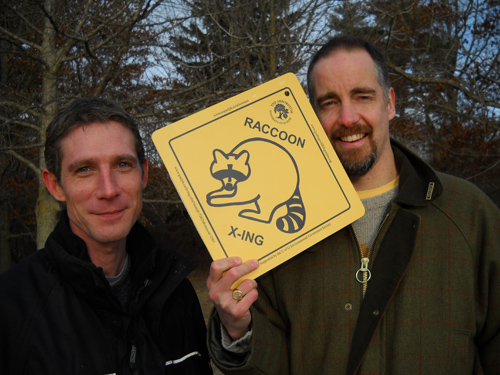
Slow down and save an animal’s life. That’s what Kip Carpenter hopes motorists will do when they see the new wildlife crossing signs installed around the U of G Arboretum in January.
Lobbying efforts by the third-year undergraduate led municipal officials to install the bright yellow signs on sections of College Avenue, Victoria Road and Stone Road around the arboretum. Six signs – designed by an arboretum staffer and paid for by the city – are intended to alert motorists to animals and birds on all three busy roads.
Looking for something more eye-catching than generic signs posted elsewhere, Chris Earley, the arboretum’s interpretive biologist and education co-ordinator, designed the distinctive diamond-shaped signs. Each contains simple pictures of four creatures – raccoon, Canada goose, frog and turtle – and the words “Guelph Arboretum Wildlife Crossing.”
Those are among the most common creatures around the sanctuary, along with deer, opossums, foxes, owls, rabbits and snakes. Many of the smaller animals are routinely struck and killed by motorists around the arboretum.
“It happens all the time,” says Earley.
He says painted and snapping turtles lay eggs in the roadside gravel. Frogs routinely hop across between ponds. Canada geese often cross to get to the greener side. Not all of them make it. “I could go out and show you a dead raccoon right now.”
He wasn’t the only one to notice the carnage. Carpenter, a third-year student in environmental governance and geographic information systems, often walks through the arboretum to and from class.
He had made a habit of collecting litter along his route. But then he noticed a lot of road kill.
Drawing on his governance lessons, he wrote to city staffers early last year. “Understanding how different levels of government operate allowed me to approach them more efficiently,” he says.
At first he hoped the city might lower speed limits on all three roads – not just for the safety of wildlife but for his own sake and that of other pedestrians.
Pointing to the posted limits – 70 kilometres an hour on Victoria, 60 on College and Stone – and the absence of bike lanes, he says, “Victoria Road is very dangerous for people as well.”
When city staffers turned down that request, he approached the arboretum about other ideas. He and Earley decided to ask about posting wildlife crossing signs.
The city agreed and paid for the signs, including one near the main arboretum entrance on College Avenue just west of Victoria Road.
Joanne Starr, the city’s supervisor of traffic investigations, says speed limits are set based on various factors including land uses and road type. “The speed limits are appropriate for those sections,” she says, adding that she spoke to city environmental planners to confirm wildlife “traffic” around the arboretum.
“The intent behind the signs is to warn motorists of the potential to encounter wildlife that could cause injury or damage,” says Starr. Earlier, the city had posted deer-crossing signs in several locations on Kortright Road, Gordon Street and Edinburgh Road.
Now the arboretum is selling its own plastic versions of the signs (minus the posts), each showing an individual animal or bird along with website addresses for the arboretum, its Gosling Wildlife Garden and the City of Guelph. Earley thinks they might be a hit among students looking to brighten up a bare dormitory wall with something eye-catching and offbeat.
A mature student and former restaurant chef, Carpenter was drawn here partly because he’d heard of the University’s environmental ethos. He belongs to the student environmental governance society and is on the board of Transition Guelph, a local sustainability group.
How to tell whether the new signs are working?
Carpenter says “success would be hard to measure.” Still, he hopes the city might take further steps – maybe installing culverts as animal corridors during future road works. “I’ve already contacted them about that.”
Starr says no one has called her office about the new crossing signs. “I drive through those areas at an appropriate speed,” she says. “The signs didn’t change my driving significantly, but hopefully for others they will raise awareness that this is a unique area you’re entering and you will encounter wildlife.”